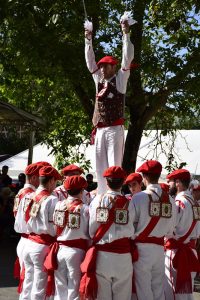Basque dances
The Lea-Artibai region is a clear example that dance is part of the idiosyncrasy and spirit of the people: its small geographical area has at least five different dances, which are totally local.
Kaxarranka:
Kaxarranka is one of the most well known dances. Originated in the brotherhood and guild of fishermen of Lekeitio and commemorates the day on which it chose its new butler. It is traditionally danced on St. Peter’s Day (June 29th). The peculiar dance is performed on a “Kutxa” or chest held on the shoulders of eight fishermen.

Aurresku
The aurresku is a Basque dance that is danced as a form of reverence. It is performed by a chistulari (musician who plays the chistu and drum) and a dantzari (dancer). This dance is very popular at weddings, tributes and public events in the Basque Country . Lea Artibai’s special feature is the “Andre Aurreskua” dance, a female version of the classic aurresku, in which the dantzaris (women) ask the men to dance.

Xemeingo Dantza or San Migel de Arretxinaga
In the town of Markina-Xemein the “Xemeingo Dantza”, also known as “San Miguel de Arretxinaga”, has its origin. This “espatadantza” represents the fight of good against evil and has historically been executed on the 29th of September, the festival of San Miguel.

Mahai Gainekoa
The one known as “Mahai Gaineko” is a local dance whose origin is in Mendexa. It is performed on a table by the dantzaris (men and women) and is traditionally danced on August 1st, the feast of San Pedro Ad Vincula.

Zahagi Dantza
The “Zahagi Dantza” (Dance of the Skin), another of the local dances, is performed during the carnivals of the towns of Markina-Xemein and Ondarroa. As for the dance, the girls and boys holding the sticks are placed in two rows, facing each other, and while those carrying the work dance back and forth, they beat the work with their sticks.
